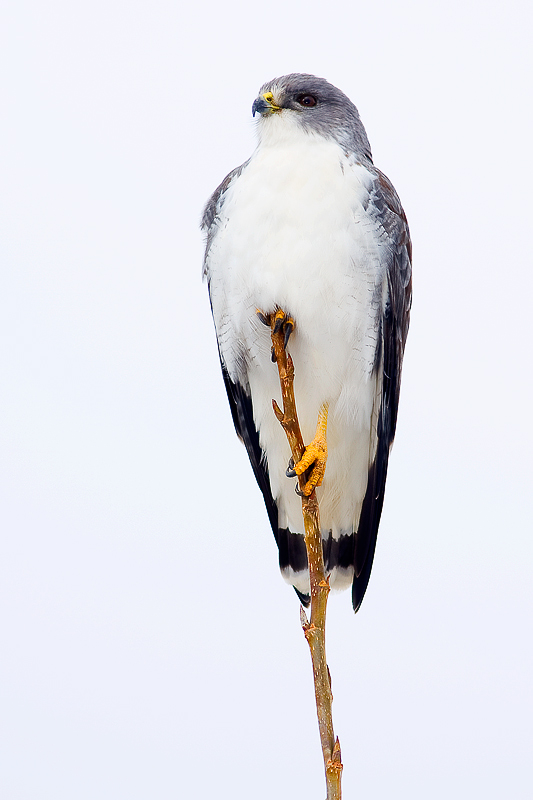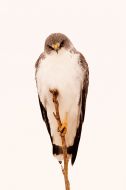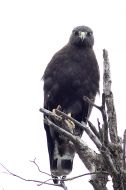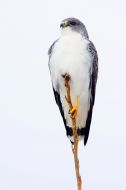Red-backed Hawk
Aguilucho Común
Buteo polyosoma
Length: 460mm (male) and 550mm (female). Sexual dimorphism. Male: bill slate grey with a black tip, cere yellow; iris dark brown; anterior part of forehead white; rest of forehead, upper parts and sides of head, hind neck, back, scapulars and rump ash grey; uppertail coverts white; rectrices white with broad black subterminal band and fine dark grey transversal streaks; wing coverts as back with
dark grey barring; secondaries ash grey with white terminal band and dark grey streaks; primaries greyish brown with outer vexillum paler than the inner one; underwing coverts and axillaries white; primary wing coverts have dark grey tips; remiges are ventrally whitish with dark grey barring; secondaries have blackish subterminal and white terminal banding; primaries show blackish tips; chin, throat, foreneck, breast, flanks, abdomen, thighs and undertail coverts white; on sides of breast there are grey feathers with white margins;
the white in flanks is striated and finely barred with grey; thighs are finely barred grey. Legs yellow. Female: bill and iris as in male; head as in male but with darker and browner grey; upper back and scapulars reddish chestnut; greater scapulars are striated with black along rachis with whitish spots. Remainder of plumage as in male; darker on upper side of wings.
Legs yellow. The above descriptions are for the typical and most common adult phase in both sexes. There are, however, other dark stages which are described as follows: Male: bill, legs and rectrices as described for the typical stage; rest of plumage entirely slate grey. The dark phase in the female is similar, but grey is darker and back is dark red chestnut. Moreover, in some individuals the breast is also dark red chestnut. Fledglings during the first stage show slate grey on the bill and black to tip, greenish cere, iris greyish brown, upper forehead white, rest of forehead and upper parts of head dark brown chestnut with ochraceous buff margin to feathers; supraocular band, auricular and postauricular regions, ochraceous buff; chin and throat ochraceous buff with blackish brown spots in mid throat; malar region and lower part of cheeks blackish brown; hind neck, back and scapulars chestnut brown with buffy ochre margins and markings as in scapulars; rectrices brownish grey with dark brown to blackish banding. Lesser and median wing coverts dark brown with buffy ochre margins and grey speckles in inner vexillum; greater wing coverts and secondaries brownish grey with fine blackish banding and thin whitish terminal band in secondaries; primaries brownish grey with blackish bands. Underside of wings show ash grey remiges with greyish brown barring and brownish grey tips; underwing coverts and axillaries are ochraceous buff with reddish patterns and blackish spots in those coverts covering the base of the primaries. Breast cinnamon ochre striated dark brown; sides of breast are dark brown with cinnamon ochre margins; abdomen and flanks rufous buff with dark brown spots and streaks; thighs ochraceous buff with reddish spots; undertail coverts ochraceous buff with reddish undulated banding. Legs greenish. In addition to the phases described above, there are some transition plumages in young and subadults and a wide range of intermediate and individual variation which leads to confusion. Habitat and behaviour: one of the most common raptors, the Red-backed Hawk is chiefly found in pairs that perch high in exposed sites such as the top branches of shrubs and trees, rocks, fences or telephone posts; during its foraging flights it flies at regular height; when there is wind, it usually stays motionless, hovering at the edge of slopes and hills scanning for prey. Food consists on rodents, birds, reptiles and abundant insects. This species often harries the Elegant Crested- Tinamou (Eudromia elegans) and the Patagonian Tinamou (Tinamotis ingoufi) perched on some shrub to be able to catch them unawares; apart from small animals and other prey, it will also feed on the carcass of animals that are run over by vehicles. In the Patagonian region it is known as Ñanco by the native people and its presence, according to the side of the road where it is seen, signals good luck or a bad omen, as well as whether it is facing the observer or showing its back. Nests are built of intertwined twigs lined with grasses, wool and skins. The nest is a big platform used over the years; its size increases each season as more material is added to renew it; females lay up to four eggs whitish in colour with a few chestnut brown speckles. Both sexes take on parental duties; sometimes small rodents are left in the nest for nestlings to feed on; there may be striking colour differences among chicks in the same clutch. Dark phase individuals are more commonly found in woodlands; the typical phases, however, are found in all environments. Range: distributed throughout Patagonia and Islas Malvinas, further north it occurs in the centre and northwest up to Jujuy; in Chile it is found from Tierra del Fuego to Arica and in the Andean region it occurs up to Ecuador and Colombia.
Illustrated Handbook of the Birds of the Patagonia
Kindness: Kovacs Family |











